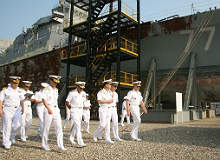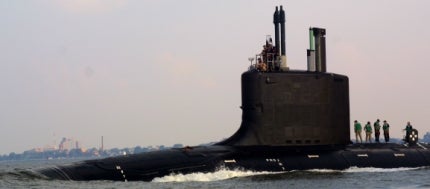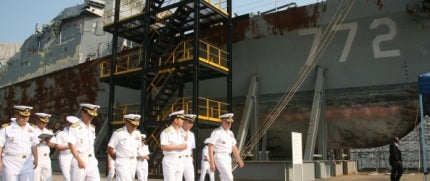
The Rim of the Pacific Exercise (RIMPAC) 2012, the world’s largest international maritime warfare exercise, is scheduled to start on 29 June 2012. In all, 42 ships, six submarines, 200 aircraft and 25,000 personnel from 22 different nations will descend upon Hawaii, US, in an attempt to bolster interoperability between the US Navy and allied forces located within the Pacific Rim.

US Marines disembark Amphibious Assault Vehicles during a mechanized raid in support of exercise Rim of the Pacific (RIMPAC) 2004. Photo courtesy of US Navy
Not only is the exercise designed to increase stability in the region, but it also provides a key opportunity for participating naval forces to experiment with emerging technologies and concepts. Not only will the US Navy use RIMPAC 2012 to demonstrate its Great Green Fleet of biofuel-driven vessels, but it will also experiment with blue-laser communications technology which could revolutionise the development of submarines and remotely operated vehicles (ROVs).
US Navy’s biofuel powered ‘Great Green Fleet’
Making its first appearance at RIMPAC is the US Navy’s Great Green Fleet, made up of aircraft and vessels such as the F/A-18 Super Hornet, the USS Nimitz and the USS Arleigh Burke-class guided missile destroyer, USS Chafee, which are powered using a biofuel blend to demonstrate the US Navy’s development of a more environmentally-friendly naval force. The initiative is tasked with deploying a fleet of warships powered by alternative fuels by 2016.
Related project
Nimitz Class Aircraft Carrier
The Nimitz Class aircraft carriers are the largest warships ever built. With over 6,000 personnel (crew and aircrew), the carrier has a displacement of 102,000t, and a flight deck length of 332.9m.
The US Defence Logistics Agency has purchased 450,000 gallons of biofuel to power the navy’s carrier group during the exercise, representing the largest single purchase of biofuel in history at a cost of $12m. A mixture of algae-based fuel and fuel developed from used cooking oil and non-food-grade animal fats has been ordered from Dynamic Fuels and Solazyme, which will be combined in a 50/50 blend with petroleum-based diesel and aviation fuel.
The testing hopes to build on the success of the Oliver Hazard Perry-Class frigate USS Ford’s 12,000 mile trip using a biofuel blend, which it completed in March 2012. US surface combatants and carrier-based aircraft will be used to "test, evaluate and demonstrate the cross-platform utility and functionality of biofuels", according to the US Navy.
The investment into biofuel research has not, however, been without controversy. The US Department of Defence has been met with a political backlash for what some politicians have labelled as a misdirection of resources, which should be diverted towards the acquisition of new vessels instead.
As questions continue over why the navy’s ship budget has been slashed but investment into expensive biofuels has increased, Navy Energy Coordination Office director James Goudreau said: "Alternative fuels for the navy is not about being green, it’s about combat ability."
Despite Goudreau’s assertion, Republicans on the House Armed Services Committee have still attempted to ban the US Navy from producing or buying any alternative fuels which cost more than traditional fossil fuels.
Submarine-friendly blue laser communications

Submarines such as the USS Virginia could benefit greatly from the development of blue-laser communication systems. US Navy photo by Journalist 2nd Class Christina M. Shaw.
Another area which has captured the US Navy’s attention is the advancement of blue-laser communications technologies, which will be field tested during RIMPAC 2012.
Related project
NSSN Virginia Class Attack Submarine
The Virginia Class new attack submarine is an advanced stealth multimission nuclear-powered submarine for deep ocean anti-submarine warfare and littoral (shallow water) operations..
Should testing prove to be successful, the technology could not only enhance communications between submarines and assets above the surface, but also make the use of ROVs more feasible.
The current standard of communications relies upon radio waves, which cannot penetrate through sea water. This has led to submarines requiring the use of towed buoys or trailing wires to communicate with warships or aircraft effectively. Blue / green laser wavelengths are, however, capable of penetrating sea water effectively and have been eyed as a potential communication medium for some time.
The stumbling block which has prevented previous use aboard submarines has been the laser transmitter. It is a required component for the system, but usually either a Raman shifted XeCI examiner laser or a frequency-doubled Ti Sapphire source is considered too bulky, inefficient and impractical for installation aboard modern submarines, where space is at a premium and demands are high.
This prompted DARPA to award a $32m contract in September 2010 to develop a blue-laser system under the Tactical Relay Information Network (TRITON) programme, with a live evaluation of the system scheduled to take place during RIMPAC 2012.
A Broad Agency Announcement from DARPA signalled RIMPAC as a key event during the system’s development, adding: "By programme completion, DARPA and the navy are expecting a clear demonstration of the maturity of key laser technology components and its performance as a future operational system."
QinetiQ’s North American subsidiary secured the contract having already started development of a blue-laser communication system dubbed the Submarine-Enabling Airborne Data Exchange and Enhancement Program (SEADEEP).
At the time of the contract award, QinetiQ confirmed that its SEADEEP system had already demonstrated "communications through the air-water interface equivalent to data rates available with wideband Internet communications at home", equivalent to being hundreds of times faster than conventional submarine communications at operational depths.
Addressing increasing instability on the Korean Peninsula

South Korean and US Navy admirals inspecting the wreckage of the Cheonan at Pyeongtaek on 13 September 2010. US Navy photo by Lt. Jared Apollo Burgamy.
Aside from the operational testing of emerging technologies, RIMPAC 2012 will also see participating nations conduct a number of drills and exercises designed specifically to increase interoperability.
Related project
Sejong the Great Class Destroyer
The Sejong the Great Class guided missile destroyers are being developed under the Korean Destroyer eXperimental (KDX) programme of the Republic of Korea Navy (ROKN).
South Korea will be hoping that its contingent of the ROKS Yulgok Yi-I and Choi Young destroyers, the Chang Bogo-Class submarine, a P-3C surveillance plane and a Lynx anti-submarine helicopter will help establish itself as a key participant in the exercise amid a backdrop of escalating tensions in the Korean Peninsula.
March 2010 saw the sinking of ROKS Cheonan and the deaths of 46 South Korean sailors. Suspected to be the result of an attack from a North Korean submarine, tensions in the region mounted as the US condemned the attack without explicitly naming North Korea as the perpetrator. This was followed by the North Korean shelling of Yeonpyeong Island in November 2010, killing two civilians and two soldiers.
Former UN ambassador Bill Richardson said after the bombardment of Yeonpyeong that tensions had become "the most serious crisis on the Korean Peninsula since the 1943 armistice which ended the Korean War."
Escalating tensions, enhanced by Kim Jong-Il’s death and North Korea’s recent failed satellite launch, have resulted in a degree of uncertainty in the Yellow Sea region and Korean Peninsula, but the US will hope to alleviate fears with South Korea’s participation in the exercise.
Although South Korea has been a repeat participant in the exercise since 1990, RIMPAC 2012 will see the first demonstration of a South Korean marine platoon in order to boost amphibious landing operational capabilities, in what could be seen as a direct response to the bombardment of Yeonpyeong.
Related content
RIMPAC 2012: participating vessels by country
As nations around the Pacific Rim descend upon Hawaii for the start of the RIMPAC 2012 exercise, naval-technology.com profiles the participating nations and compiles a complete list of vessels set to feature in the exercise.
RIMPAC 2012: the aircraft and helicopters
As nations around the Pacific Rim descend upon Hawaii for the start of the exercise, naval-technology.com, in partnership with airforce-technology.com, profile the naval aircraft and helicopters taking part in the exercise.







